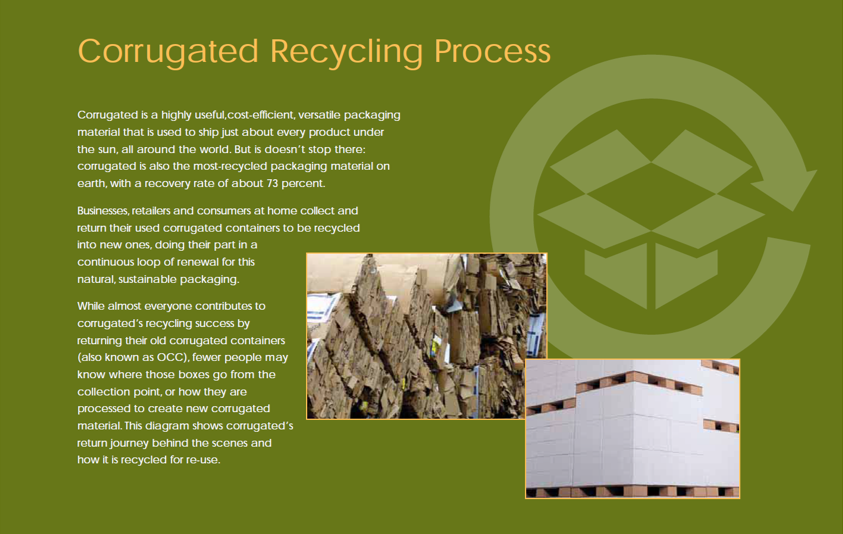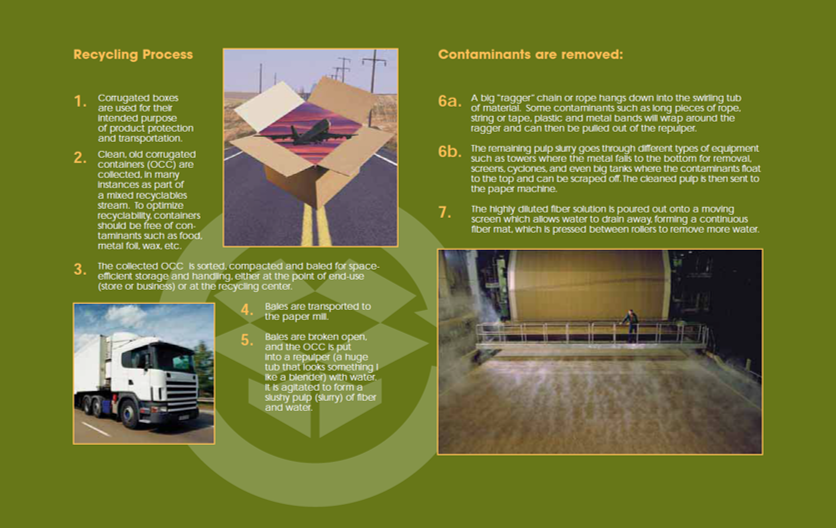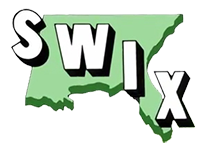Cardboard Recycling Smart Choices for the Future

Article Source: Corrugated Packaging Alliance
Smart choices today give the future a great start.
Making smart, responsible choices means having a vision for the future. That includes the life cycle of your packaging. The average corrugated box consists of 47 percent recycled fiber.
We continue to set recovery goals and find new ways to minimize waste. That’s the smart choice for everyone.
Corrugated is the single most recycled packaging material: 91 percent of corrugated produced in 2012 was recovered for recycling, and almost all of that material was recycled into new products.
Why Recycle?
Recycling corrugated helps decrease solid waste disposal in landfills. It also provides fiber that is reused to make new corrugated, so we can use less new, raw material. Recycling corrugated even earns revenue for the end-user, because that recovered material (called “OCC,” for “old corrugated containers”) is valuable to paper mills and manufacturers of new corrugated.
How Corrugated Recycling Works
Corrugated is the most-recycled packaging material on earth, with a 2012 recovery rate of over 91 percent. Businesses, retailers and consumers at home collect and return their used corrugated containers to be recycled into new ones. While almost everyone contributes to corrugated’s recycling success, fewer people may know where those boxes go from the collection point, or how they are processed to produce new corrugated material.
Here’s how corrugated is recycled:
1. Corrugated boxes are used for their intended purpose of product protection and transportation.
2. Clean, old corrugated containers (OCC) are collected, in many instances as part of a mixed recyclables
stream. To optimize recyclability, containers should be free of contaminants such as food, metal foil, wax,
etc.
3. The collected OCC is sorted, compacted and baled for space-efficient storage and handling, either at the
point of end-use (store or business) or at the recycling center.
4. Bales are transported to the paper mill.
5. Bales are broken open, and OCC is put into a repulper (a huge tub that looks something like a blender) with
water. It is agitated to form a slushy pulp (slurry) of fiber and water.
6a. A big “ragger” chain or rope hangs
down into the swirling tub of material. Some contaminants such as long pieces of rope, string or tape, plastic
and metal bands will wrap around the ragger and can then be pulled out of the repulper.
6b. The remaining pulp slurry goes through different types of equipment such as towers where
the metal falls to the bottom for removal, screens, cyclones, and even big tanks where the contaminants float
to the top and can be scraped off. The cleaned pulp is then sent to the paper machine.
7. The highly diluted fiber solution is poured out onto a moving screen which allows water to drain away, forming
a continuous fiber mat, which is pressed between rollers to remove more water.
8. The wet, continuous fiber web is then wound through the dryer section where the top and bottom of the web
alternately contact the heated surfaces of the drying cylinders, removing the remaining moisture from the
paper.
9. At the end of the paper machine, paper is rolled up on a large reel spool, which can weigh 10-60 tons.
10. The reel is then slit and rewound into individual rolls that weigh approximately 3 tons each. The recycling
process is complete; the new paper rolls are shipped to box manufacturers to begin the next stage in life to
become new corrugated boxes.
NEED ASSISTANCE WITH CARDBOARD RECYCLING?
WE SPECIALIZE IN MATERIALS EXCHANGE
OUR OFFICE SERVES TO CONNECT MATERIALS PRODUCERS AND USERS
CONTACT 800-441-7949
Corrugated Cardboard Recycling Process
(an overview)



Posted in: Company News
Leave a Comment (0) ↓
